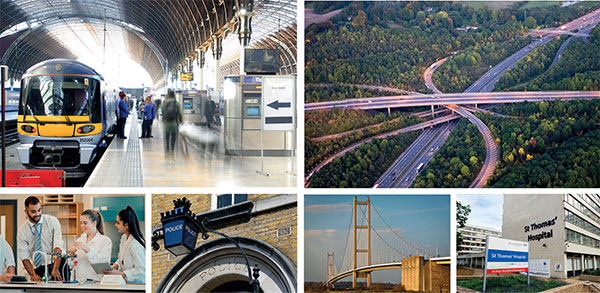Reliable income via social infrastructure trusts appeals in uncertain markets
These investment trusts’ dividends are mostly well supported by revenue streams.
6th July 2020 14:51
by Fiona Hamilton from interactive investor
These investment trusts’ dividends are mostly well supported by revenue streams.

Social infrastructure such as hospitals, schools, police stations, bridges and roads plays a critical part in our lives. Most governments are keen to outsource the costs of providing it, and in recent years, the UK and other governments have made extensive use of public-private partnerships (PPP) to do so.
Three of the four social infrastructure investment trusts in operation were formed to invest in concessions to run these PPP-funded facilities, generally after construction was completed. This has enabled them to offer attractive and steadily rising dividends – financed by revenue based predominantly on the availability of those facilities (rather than their, less predictable, use) – with partial inflation linkage funded by government-backed counterparties.
- Investment Trust Awards 2020: Best Infrastructure Trust
Such reliable income has proved so attractive to investors that HICL Infrastructure (HICL) andInternational Public Partnerships (INPP), which pioneered the sector in 2007, have grown into the fifth- and seventh-largest closed-ended funds quoted on the London Stock Exchange; BBGI, which joined them in 2011, has also won a massive following. Their well-supported dividends look even more appealing in today’s uncertain markets, particularly for those worried about the downward pressure on dividends and dwindling bond returns.
However, it should be noted that the concessions to manage most PPP-funded social infrastructure facilities expire worthless within 25 years or so. This means that medium-term growth in the three trusts’ NAVs per share is likely to be limited at best and liable to fall steeply in the next 20 years or so, unless they can keep raising new money and investing it on equally attractive terms. That could involve investors in a bit more risk, as demonstrated by problems with some of the trusts’ more recent investments.
For their first nine years, HICL and INPP invested almost exclusively in UK PPP/PFI concessions. As a result, their NAV returns were virtually unaffected by the global financial crisis, their dividends grew steadily, they achieved their target annual returns of around 8%, and their shares traded at useful premiums. This meant they could regularly raise substantial additional capital on terms that enhanced their NAVs and which funded the purchase of concessions extending the life of their portfolios.
The situation has changed in the past four years, due to the lack of new PPP/PFI projects in the UK and fierce competition for any secondary opportunities. Both trusts have therefore diversified, exposing themselves to new risks.
Dwindling demand
PPP projects now account for just 72% of HICL’s portfolio, whereas 20% is in demand-based assets such as toll roads in the US and France, and the UK’s HS1 rail link. While HICL’s PPP projects have not suffered in the pandemic, its demand-based assets have, and could continue to do so for up to two years.
As a result of these specific problems, HICL lowered its NAV per share by 4p, having already reduced it by 2.2p due to problems with Affinity Water, which dominates the trust’s 8% exposure to regulated assets and is not expected to pay HICL any dividends for five years. The net result is that the NAV total return for the year to the end of March 2020 was just 1.9%, reducing its annual average since launch to 9%. In addition, it has dropped its commitment to steadily rising dividends and is holding the payment for 2020/21 at 8.25p. There is no guidance for 2022.
Looking ahead, the weighted average remaining life of HICL’s 117 infrastructure assets is 28.5 years, and its returns have a 0.8% positive correlation with inflation*. Following a setback this year, HICL’s cash flow is expected to grow quite strongly until 2032, struggle to hold that level until 2042 and then drop quite rapidly unless contracts are extended or new assets bought in, as seems highly likely.
INPP has also diversified substantially, with UK and international PPP assets down to 18% and 23% of the portfolio respectively. However, its exposure to demand-based assets is largely limited to its stake in a Belgian rail link (9% of assets). Reassuringly, the downside on this front is limited by contractual mitigants, as it is with its stake in the Thames Tideway project (also 9%), where building delays have pushed up costs.

Robust revenues
Regulated assets now account for 40% of INPP’s portfolio, and are substantially insulated from GDP trends. Its stake in gas distributor Cadent (17% of assets), for instance, offers government-backed, index-linked revenues and no exposure to commodity or demand risks. However, changes to regulatory regimes could affect its income (as they have done at HICL’s Affinity Water).
INPP has achieved annualised shareholder returns of 9% since IPO and most of its holdings have not been significantly disrupted so far this year. Dividend growth remains intact, with targets of 7.36p and 7.55p for the years to 31 December 2020 and 2021 respectively.
Its portfolio of 130 projects has an average weighted life of 34 years and inflation linkage is high at 82%. Barring further acquisitions (which it is well placed to finance), investment receipts are expected to peak in 2038 at more than 50% above the current level, then continue at around 75% of the current level until 2047.
BBGI generally trades on a higher premium than HICL or INPP because it is committed to investing exclusively in concessions to run fully operational projects where government-backed revenue is based solely on availability. It has achieved this by using its “strong relationship with leading construction companies” to source suitable projects overseas, leaving it with UK exposure of just 32%.
BBGI’s 2019 dividend of 7p was 1.3 times covered, and the trust is targeting 7.18p for 2020 and 7.33p for 2021. On the downside, its portfolio’s inflation linkage is only 0.5% and the weighted average life of its 48 assets is just 20 years. The managers state that if the trust makes no further acquisitions, it will enter into the repayment phase in 2035, after which cash flows will be repaid to shareholders as capital. However, it has an “attractive global pipeline” of availability-style assets, and in the past it has had no difficulty raising fresh capital.
3i Infrastructure, which is the other large social infrastructure fund, is totally different. It invests in unquoted companies involved in essential services in sectors such as healthcare, communications and transportation, which own their assets in perpetuity and with whom it works closely to enhance returns. It focuses on the UK and northern Europe, targets long-term capital and income growth and has performed impressively in recent years, thanks to a series of rewarding realisations.
With scant availability-based government- backed revenue, its holdings are more vulnerable to macroeconomic problems, as demonstrated by the current problems at TCR (12% of assets) which owns and leases airport ground support equipment. Against that, 3i Infrastructure’s other holdings are proving relatively resilient and around a quarter of its assets are in cash or receivables, leaving it well-placed to buy interesting propositions at distressed valuations. Its managers are targeting a 6.5% increase in the dividend, to 9.8p a share, for the year to March 2021.
Infrastructure trust performance over one, three and five years
| NAVTR (%) over: | ||||||||||
|---|---|---|---|---|---|---|---|---|---|---|
| Share price (p) | Prem (%) | Prem/disc 12-mth range (%) | Yield (%) | 5-yr div growth * (%) | Net assets (£m) | 1yr | 3 yrs | 5 yrs | Geographic exposure | |
| 3i Infrastructure | 275 | 7.9 | 27.9 /-26.5 | 3.6H | 1.71 | 2,267 | 14.7 | 59.9 | 94.4 | 51% UK 47% Europe, 2% Asia Pac |
| BBGI | 162 | 17.8 | 30.6/-5.4 | 4.4 H | 3.98 | 866 | 7.5 | 28 | 62.7 | 32% UK,12% Europe, 44% N Am, 12% Asia Pac |
| HICL | 173 | 12.2 | 14.4/-12.9 | 4.8**Q | 2.54 | 2,874 | 1.8 | 18 | 43.2 | 75% Uk, 17% Europe, 8% N Am |
| Intl Public Prtnrshps | 164 | 8.7 | 13.8/-15.6 | 4.5 H | 2.65 | 2,431 | 6.7 | 22.3 | 51.3 | 73% UK, 14% Europe, 5% N Am, 8% Australia |
Notes: H = semi annually, Q = quarterly. *Provided by the AIC. **Adjusted to take account of forecast dividend cuts. Source: Figures based on data provided by Numis Securities to 3 June 2020.
Solid choices
Most analysts view the social infrastructure trusts as attractive sources of income in current market conditions. Investec’s Alan Brierley particularly favours HICL, and also likes 3i Infrastructure. Colette Ord, at Numis Securities, regularly champions INPP. Winterflood’s Kieran Drake favours BBGI because of its lower-risk approach.
Stifel’s Iain Scouller also likes BBGI’s lower-risk portfolio and suggests that it deserves a mid-teen premium. He says HICL and INPP would benefit most if measures to reflate the UK economy result in inflation flaring up.
As with the renewable infrastructure trusts, shares in the social infrastructure trusts can generally be bought at lower premiums when funds are issuing new capital.
*If inflation is 1% a year higher than the valuation assumption in every forecast period, the expected return from the portfolio would increase by 0.8%.
This article was originally published in our sister magazine Money Observer, which ceased publication in August 2020.
These articles are provided for information purposes only. Occasionally, an opinion about whether to buy or sell a specific investment may be provided by third parties. The content is not intended to be a personal recommendation to buy or sell any financial instrument or product, or to adopt any investment strategy as it is not provided based on an assessment of your investing knowledge and experience, your financial situation or your investment objectives. The value of your investments, and the income derived from them, may go down as well as up. You may not get back all the money that you invest. The investments referred to in this article may not be suitable for all investors, and if in doubt, an investor should seek advice from a qualified investment adviser.
Full performance can be found on the company or index summary page on the interactive investor website. Simply click on the company's or index name highlighted in the article.